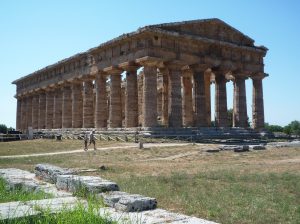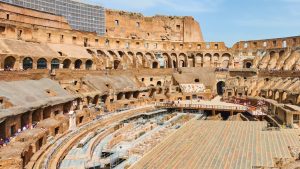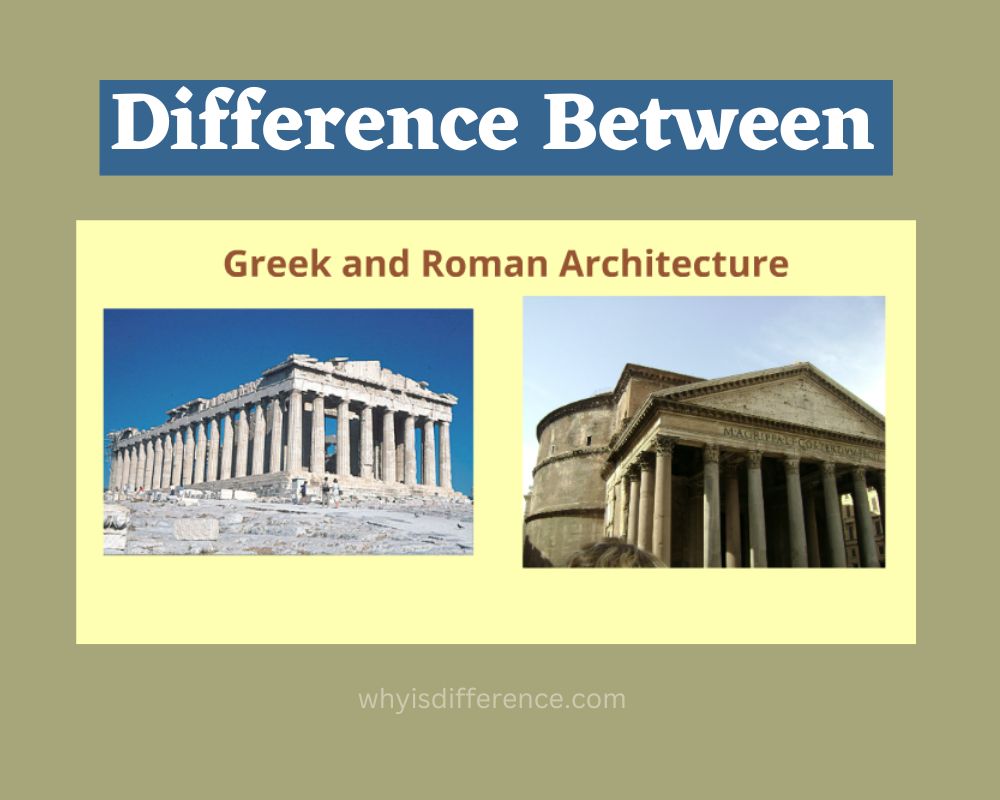Greek and Roman Architecture: Some people may not see the difference between Greek and Roman architectural styles because they are so similar. This does not mean that there are no differences between the two styles. This is the simple explanation of why there are so many similarities in appearance. The Greek civilization and its architects came before the Roman civilization. The Roman civilization, therefore, borrowed elements of Greek architecture at their time. Roman architecture has its own unique style. This article will discuss all of these so you can get a better idea of the differences between Greek and Roman architectural styles.
Overview of Greek Architecture

Greek architecture refers to the architectural principles and styles developed by ancient Greeks between the 9th Century BC and the 1st Century CE. It is widely recognized for its profound impact on Western architectural traditions; Greek architects were noted for emphasizing harmony, proportion, and balance, as well as respecting human scale in their design principles and styles.
The Greeks produced three distinct architectural orders, Doric, Ionic, and Corinthian. Each order featured distinctive features that made them distinct column designs and entablature elements. For instance, Doric Order columns featured fluted shapes without bases and an undecorated frieze while Ionic Order’s ornate yet thin columns boasted volutes on their capitals as well as continuous relief sculptures in their frieze decoration. Finally, the Corinthian Order was the most elaborately decorated with intricately carved leaves of Acanthus at its capital for additional decoration and extravagance.
Greek architects employed the post-and-lintel technique, with vertical columns supporting horizontal beams. Durable materials like marble, wood, and limestone were utilized for their construction projects. Furthermore, Greek sculptors, craftsmen, and architects often displayed their exceptional skills through intricate stone carvings integrated with architectural details.
Greek architecture was greatly shaped by both mythology and religion, reflecting both civic values as well as mythological concepts. Temples were the primary architectural form dedicated to various gods and goddesses and provided places of worship with idealized human figures depicted through sculptures, reliefs, and statues. Greek architects endeavored to achieve harmony between their built environment and nature through harmonious design solutions.
The Parthenon in Athens – a temple dedicated to Athena – stands as a testament to Greek architecture. Other outstanding examples are the Temple of Zeus at Olympia which showcases its scale as well as the Theatre of Epidaurus which stands as an iconic example. Greek architecture continues to exert an enormous impact on contemporary practices with its emphasis on proportion, balance, and aesthetic beauty.
Brief Overview of Roman Architecture

Roman architecture refers to the styles and techniques of ancient Roman architecture between 2 BC and 5 CE. Roman structures range from public buildings to private residences; their styles have had an enormous influence on architectural traditions worldwide.
Roman architecture stands apart from Greek in that it places more importance on monumentality, grandeur, and engineering ability. Roman builders were master artisans who pioneered large-scale projects using innovative techniques.
The Roman architecture featured vaults and domes. Arches allowed for spacious interiors, bridges, aqueducts, and vaults of arched structures stacked back-to-back to provide structural support of buildings; domed roofs provided large interior spaces like Rome’s Pantheon.
The Romans revolutionized construction by pioneering concrete as a primary building material. Utilizing volcanic ash and aggregate, concrete was developed into an extraordinarily durable yet versatile substance – even used to construct massive structures like the Colosseum with a capacity for hundreds of spectators at one time!
Roman architecture was an amazing display of engineering innovation and genius. Aqueducts were constructed as intricate networks of channels and bridges to transport water into cities for use by public fountains, baths, and private residences alike. Basilicas, triumphal archways, and thermal baths also marked this period in architectural design history.
The Romans were heavily influenced by various cultures such as the Greeks, Etruscans, and Egyptians; adapting and incorporating their elements into architectural designs. Mythology, imperial propaganda, and sculptures depicting gods, emperors, or historical events had a considerable effect on Roman architecture as an art form.
The Colosseum stands as a monument to Roman engineering, entertainment, and art, while its French counterpart the Pantheon displays its expertise in construction techniques and engineering design. Roman architecture has had an indelible mark on history’s architectural legacy. Influencing subsequent movements and becoming the cornerstone of classical design, its influence can still be found worldwide in numerous structures that reflect Roman design’s lasting presence and innovations.
Comparison Table Between Greek and Roman Architecture
| Aspect | Greek Architecture | Roman Architecture |
|---|---|---|
| Time Period | Predominantly 9th to 1st century BCE | 2nd century BCE to 5th century CE |
| Design Principles | Harmony, balance, proportion | Monumentality, grandeur, engineering prowess |
| Architectural Orders | Doric, Ionic, Corinthian | Doric, Ionic, Corinthian, Composite |
| Construction Technique | Post-and-lintel | Arch, vault, dome, extensive use of concrete |
| Material Preference | Marble, limestone, wood | Concrete, stone, brick |
| Ornamentation | Elaborate stone carving, sculptural details | Sculptural reliefs, decorative intricacies |
| Influences | Mythology, religion, civic values | Greek architectural elements, Roman mythology |
| Structural Elements | Emphasis on columns and entablature | Extensive use of arches, vaults, and domes |
| Purpose | Temples, theaters, civic buildings | Amphitheaters, baths, basilicas, triumphal arches |
| Examples | Parthenon, Temple of Zeus, Theater of Epidaurus | Colosseum, Pantheon, Pont du Gard |
Design Principles
Both Greek and Roman architecture had strong aesthetic elements that differed slightly. Let’s examine these design characteristics associated with both architectural styles.
Greek Architecture:
- Ancient Greek architects valued harmony and equilibrium when designing structures, striving to find equilibrium among various architectural components. To create visually appealing structures that were also aesthetically pleasing, Greek architects often employed proportional relationships such as the Golden Ratio in their designs.
- The Greeks were master architects when it comes to architectural orders; Doric, Ionic, and Corinthian were three major ones. Each order features different decorative elements and proportions which allow architects to choose one according to aesthetic and functional considerations of a building project.
- Greek architecture was known for its emphasis on columns as an essential feature, with each order using unique designs for their columns. Doric ordered featured simple, robust columns while Ionic columns featured more slender, thinner models adorned with volutes or capitals bearing acanthus leaves; Corinthian orders featured extravagant capitals featuring intricate capitals featuring elaborate capitals with acanthus leaves. Entablatures provided horizontal elements above every column in Greek architecture.
Roman Architecture:
- Roman architecture was often designed to impress, creating an impression of grandeur. Roman buildings were constructed on a grander scale to reflect their Empire’s power and authority – they are well known for their impressive structures.
- The Romans revolutionized architecture through their innovative use of arches, vaults, and domes. Arches created expansive spaces, enabled the construction of bridges and monumental gateways, and enabled the creation of aqueducts; while vaults and domes created impressive interiors while more efficiently disbursing weight distribution.
- Roman architects created the Composite Order as an innovative combination of Ionic-Corinthian architecture. This new order featured an Ionic cap with volutes and Corinthian leaves to further express decorative elements in architectural structures. This allowed architects greater freedom when it came to decorating their buildings with decorative features.
- Roman architecture was distinguished by its monumentality, engineering skill, and inventive use of vaults, arches, and domes – features that had a profound influence on aesthetics, spatial qualities, and architectural development across each architectural tradition.
Construction Techniques
Greek and Roman architectural traditions employed distinct construction techniques. Below is a breakdown of each architectural tradition’s specific methods of building.
Greek Architecture:
- Greek architecture relied heavily on a construction technique known as post-and-lintel, consisting of vertical posts (posts) which supported horizontal beams; these were connected by horizontal lintels to fill any gaps between columns for structural support of superstructures.
- Greek architects employed durable materials like marble, wood, and limestone in their structures. Marble was prized for its strength, beauty, and intricate carving. Roofs, floors and other non-visible elements of structures are often made out of wooden construction materials.
- Greek architecture was characterized by intricate stone carvings and sculptural elements crafted by skilled craftsmen with great artistic skill and precision. Friezes and metopes, among other pieces, adorned decorative components to give buildings their narrative and aesthetic significance.
Roman Architecture:
- Roman architects made extensive use of concrete. This innovation in construction technology combined lime, volcanic (pozzolana), and aggregates (such as broken bricks or stones broken up into pieces). This mix created an extremely durable yet versatile material used to construct large buildings featuring intricate architectural features.
- The Romans were masters at creating impressive interior spaces using arches, vaults, and domes. Arches provide strength while still allowing large spans. By placing several arches together they could form vaults; rotating an arch around its central axis would turn it into domes to form impressive interior spaces.
- Roman architects demonstrated exceptional engineering abilities in their construction projects. They utilized innovative techniques for crafting complex structures such as aqueducts – networks of channels and bridges used to transport water over long distances – using modern construction methods and were adept at using advanced construction methods for large amphitheaters and baths, among other monumental buildings – meticulous planning was practiced prior to every worksite visit, precise measurements taken, meticulous measurements used when measuring structures, etc.
- Greek architecture relied heavily on post and lintel structures with stone carvings and sculptured elements for decoration. Roman architecture progressed further by using concrete, arches, and vaults – techniques that helped them build monumental structures and push the limits of architectural design; leaving a lasting mark in construction fields across the Mediterranean world.
Artistic Influences
Artistic Influences Both Greek and Roman architectural themes were strongly shaped by artistic influences.
Here’s a brief look at these effects for each architectural style:
Greek Architecture: Mythology Religion and Civic Values. Greek architecture was heavily influenced by mythology and civic values, with temples often constructed to pay respects to various gods or goddesses from Greek mythology, their designs often reflecting religious practices associated with those deities as well as seeking harmony with divinity through Greek architecture.
Greek Sculptural Traditions: Greek sculpture was an integral component of architectural ornamentation. Sculptors attempted to depict idealized human figures such as gods, mythical beings, heroes and goddesses which they would then incorporate into architecture through pediments and friezes as architectural embellishments adding both narrative and artistic dimension.
Integration of Architectural Elements and Sculptural Elements: Greek architecture put great importance on combining architectural components and sculptural decorations seamlessly, thus increasing visual impact and communicating symbolic meanings through these ornamental features.
Roman Architecture was heavily influenced by Greek architectural traditions: Romans greatly admired Greek architecture and adopted many of its elements such as columns, decorative motifs, and order – adapting these features for their own aesthetics and building techniques.
Roman Mythology & Imperial Propaganda: Roman architecture was an architectural celebration of Roman mythology and its achievements; celebrating both the power and political authority of Roman emperors through sculptured elements that reinforced authority. Propaganda messages conveyed through sculptured reliefs were designed to reinforce authority.
Roman art favored naturalistic and realistic depictions: Sculptures and reliefs often featured highly realistic characters with expressive facial features and drapery that was lifelike, while architectural details featured intricate decorative features like acanthus leaves motifs or ornate freezes to enhance this experience.
Greek and Roman architecture share a rich heritage. Greek influences served as the cornerstone for Roman architectural developments; Greek architecture was founded upon mythology, religion, sculptural elements, and religious iconography. Roman architecture then integrated these artistic influences and focused on Roman mythology, imperial propaganda as well as realistic portrayals and decorative details in their depictions and ornamentation – which contributed both aesthetic richness and cultural significance to both traditions.
Examples of Greek and Roman Structures
Here are some of the most renowned structures from both Greek and Roman Architecture:
Greek Architecture:
Temple of Zeus in Olympia (Greece): Dedicated to Zeus, King of Gods, this Doric-Ionic temple located in Olympia was dedicated in his honor and included one of the Seven Wonders of the Ancient World- an enormous statue depicting Zeus himself.
Theater of Epidaurus: This ancient Greek theatre is famed for both its acoustics and architectural design. Situated at Asklepios Sanctuary in Epidaurus, it remains an exceptional example of Greek theatre architecture.
Roman Architecture:
Colosseum, Rome (Italy): The Colosseum stands as an impressive testament to Roman engineering and architecture, featuring gladiatorial competitions, animal hunts, shows, vaulted ceilings, and arched columns that define its design. It remains an impressive reminder of Roman engineering today.
Pantheon of Rome (Italy): The Pantheon is an outstanding Roman temple dedicated to the gods, featuring one of the world’s largest unreinforced concrete domes – a marvelous example of Roman engineering and architectural excellence.
Pont du Gard: Situated in France, Pont du Gard is an ancient Roman aqueduct built by Roman engineers to transport water across the Gardon River. Built as part of Roman hydraulic engineering and architectural achievements, its three levels of arches showcase their remarkable engineering prowess.
These structures stand as testaments to both Greek and Roman civilizations’ architectural prowess, standing as proof of both civilizations’ architectural skills.
Conclusion
Greek and Roman architectural contributions to history are significant. Greek architecture was noted for its harmony, proportion, balance, and emphasis on the interaction of architectural elements with sculptured ornamentation – two hallmarks of its success as seen through monuments like the Parthenon and the Temple of Zeus. Roman architecture combined engineering, monumentality, and innovative construction methods into an exquisite combination. Romans used concrete as their main building material and perfected arches, vaults, and domes – two monuments that epitomized Roman engineering feats, as well as artistic influences, were the Colosseum and Pantheon.
Roman architecture developed its own distinct style, incorporating engineering advances and aesthetic qualities that were drawn from mythology, religion, civic values, as well as imperial propaganda. Both traditions took inspiration from mythology while Roman architects added realistic depictions. Greek and Roman architectural styles have had a lasting effect on architecture throughout history, shaping modern structures as much as their style inspired it. Their architecture remains beautiful, engineering innovative and cultural significance still impresses modern architects alike; while their legacy bears witness to ancient civilization’s craftsmanship, artistic genius, and creative prowess.

